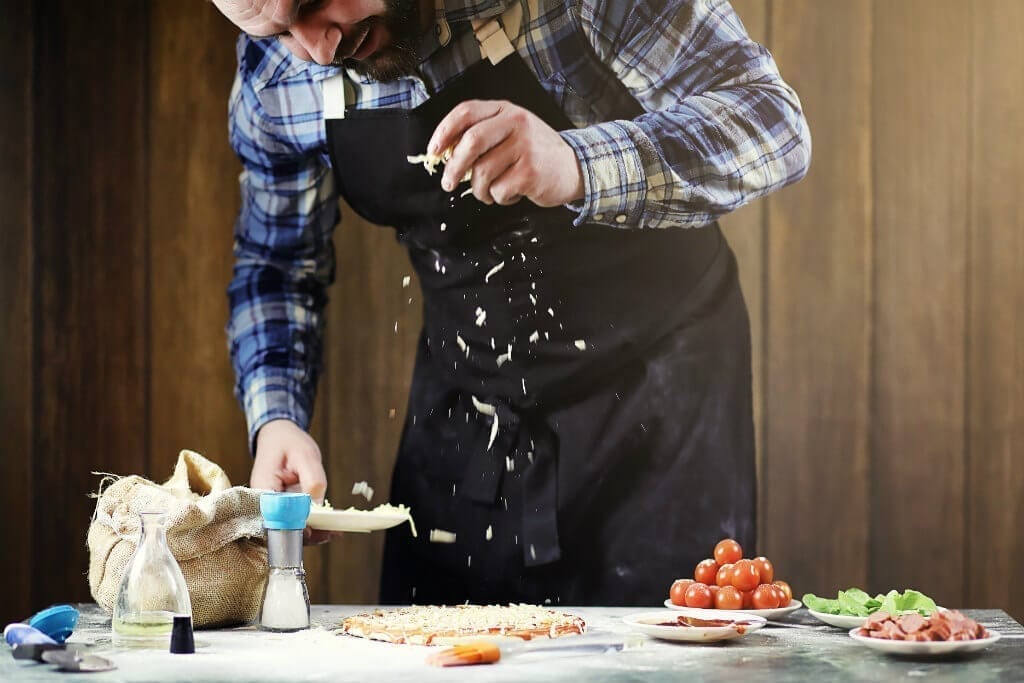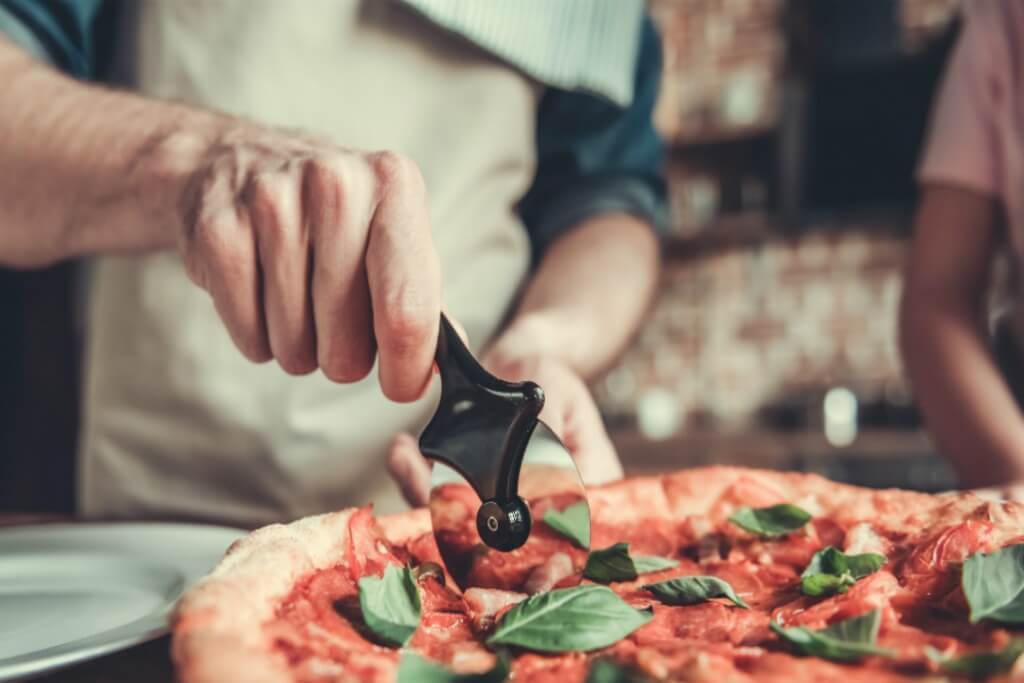Her majesty the Pizza is not a simple food but a state of mind for us Italians. Pizza has always been our North Star that has guided us through the centuries, synonymous with culture, fun and joy with friends and family sharing a genuine, simple and tasty dish so much that it has made the UNESCO’s Intangible Cultural Heritage of Humanity list.
And it’s because we want to preserve its genuineness that we give you some tips for making it at home. To prepare a home-made pizzeria-quality pizza, follow some steps. Most importantly, pizza must meet three requirements: it must be light, tasty and easy to digest. For the less experienced pizza makers, cooking may be a major headache and more so if your guests are sophisticated palates that won’t forgive you for a half-raw or overcooked pizza. So, to cook a pizza perfectly, follow these few steps and don’t be discouraged if the results are not good enough at first; perfection is attained by slow degrees, it requires the hand of time.
The biggest mistakes when cooking pizza and how to avoid them
When you play the role of pizza chef on occasion, cooking pizza in your home oven could turn out to be a bit of a let-down. Sauce and toppings sliding off, edge too thick or too high, charring on the sides are little imperfections that can threaten the success of this all-Italian delicacy. But, as the saying goes, to err is human and therefore making mistakes when baking pizza is not surprising at all. The fact is that as simple as it may be making pizza is a matter of precision and attention not forgetting a few tricks of the trade. Here is a step-by-step guide for cooking a pizza in your home oven.
Which is the best yeast for pizza dough?
The yeast is beyond doubt an essential ingredient not only in preparing pizza but also in cooking it. The past masters of pizza making recommend using sourdough starter even though active dry yeast in granules might be a viable alternative. Usually, the lower the amount of yeast, the longer the fermentation process. The idea of placing the pizza dough in the fridge to let it rise is catching on. Although pizza masters don’t disregard this trend they advise limiting the rest to 12 hours. Anyway, the oven that is off is the place to be to allow the dough to rise.
Are all flours much of the muchness? No, not in the slightest!
Needless to say, an excellent pizza is made out of high-quality flour. Pizza makers strongly recommend Tipo 0 flour (plain flour in the U.K. and all-purpose flour in the U.S.); if the pizza dough is too soft, just mix it with Manitoba flour. If you choose to go local, buy the flour from a miller to give your pizzas a retro touch.
When adding salt to the pizza dough?
The answer is very simple: add it to the finished dough. In fact, salt and yeast fight like cat and dog, they vie each other for water and a total fiasco is on the cards. Then add salt at the right time that is when all the other ingredients are blended.
Do you need sugar to make pizza dough?
Yes, you do. Sugar feeds the yeast but, if you prefer, you may replace it with honey or malt.
The rolling pin is the magic tool or an accident waiting to happen?
A little of both for different reasons: to make pizza dough at home, you can use the rolling pin if you can’t get a dough as thin as you can by hand. But don’t tell it to a pizza chef, he could really lose his rag!
I make pizza bianca because I don’t know how much tomato passata to put.
Come on, don’t exaggerate! Pizza is a matter of taste but no self-respecting Margherita will do without tomato passata. Without it, pizza will taste like a biscuit after cooking. Actually, it’s easy-peasy; drop the passata onto the centre of the crust and then spread it around with a spoon stopping at about ½ inch from the outer edge.

Why does mozzarella melt so much in a hand-made pizza?
Basically, it’s a question of moisture. Mozzarella holds so much moisture that when it melts there’s water on top of the pizza. But, as the old adage says, there’s remedy for everything, so follow these tips: slice the fresh mozzarella and put the pieces into a colander for 2 or 3 hours before using them. The same is true for buffalo mozzarella but with longer times (4 hours).
Is it wrong to top pizza with other ingredients before baking it?
Yes, it is; these ingredients would burn even before you take the pizza out of the oven. The best solution is cooking pizza with only tomato sauce on it, then adding mozzarella when pizza is nearly cooked and other ingredients according to their respective cooking times. Ham, for instance, must be put at the end of cooking while aubergines and courgettes a little time before; potatoes and sausages can withstand 15-minute cooking.
What is the best oven temperature?
Pizza is baked at 300°C (575°F) in pizzerias but this temperature is not attainable in the home oven. We recommend preheating the home oven then putting it at the max temperature by placing the pizza in the lower third. If you use a fan-assisted oven, remember to put pizza in the centre of the oven to keep it from drying out. Cooking time for a well-cooked and crispy pizza ranges from 10 to 15 minutes.
Home-made pizza: a difficult but not impossible challenge
After all these tips, one thing is clear: making a home-made pizza that tastes like a pizzeria-quality Neapolitan pizza or a pizza “al taglio” may sound like a daunting task. Despite your good intentions, a careful selection of the ingredients and painstaking attention during cooking, the end result may be under par for the aspiring pizza chef. But hang in there and stay positive! If for pizza purists, only Margherita and Marinara are worth eating, in your home-made pizza you can choose the toppings according to your taste (maybe avoiding the controversial pineapple that would make some pizza makers angry). In addition, you can use different type of flours such as hemp, khorasan, multi grain, wholemeal and so on to make pizza dough especially now that organic food products are all the rage.
Making and cooking pizza, a marriage of dedication and creativity
Despite discordant opinions among amateur pizza makers, creativity nearly always pays off. Though after the early unsatisfying attempts you can feel a bit discouraged seeing photos of appetizing pizzas posted on social media, don’t give up! Cooking a home-made pizza is a matter of motivation, dedication and passion just as an art. Has it ever happened to you that you didn’t know what to cook for a dinner with friends or for a candle-lit dinner with your date? Pizza is what you need, a savoury, healthy and inexpensive food. Have fun while you are making it and you will see, as time goes on, that with a lot of consistency your home-made pizza will be every bit as tasty as the other ones.


